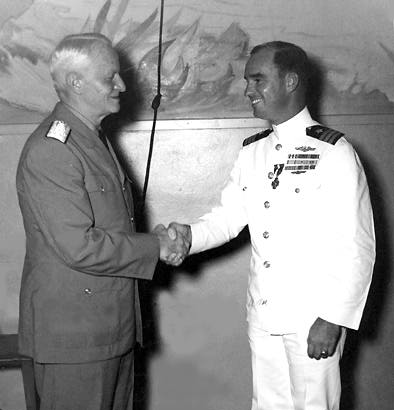Patrol Awards - Hawkbill SS-366 - (Awards)
CommendationThe USS Hawkbill received the following Navy Commendation for being responsible in sinking a total of 40,900 tons of enemy ships: Hawkbill may well be proud of the part she played in bringing defeat to our enemies. Few submarines have had a more auspicious record. Beginning her war operations when Japanese shipping had dwindled to a point where convoy contacts were a rarity, she ferreted out the enemy and succeeded in sinking many ships each patrol. Her efforts contributed in large part to the successful blockade of the Indo China Coast, severing the all important sea lanes between the Empire and her southern conquests. Throughout her war service led by Commander F. W. Scanland, Jr., U.S. Navy, her officers and men demonstrated the deadly efficacy of the American submarine. Exceptional skill and efficiency; brilliant aggressiveness; high courage: these qualities determined her success and brought her safely through many close calls. Hawkbill's final war patrol was fittingly terminated by Japan's capitulation; this capitulation was coincident with Hawkbill's colorful Anambas Island operations. It is therefore highly recommended that the Navy Unit Commendation be awarded the USS Hawkbill (SS366) for her five war patrols. The Commanding Officer has received the following awards: First War Patrol - Silver Star Medal; Second War Patrol - Bronze Star Medal; Third War Patrol - Gold Star in lieu of Second Silver Star Medal; Fourth War Patrol - Legion of Merit. 
Fleet Admiral Chester Nimitz presenting the Navy Cross to Cmdr Worth Scanland, USN at Key West FL. on a visit to the Submarine Base in the spring of 1946. This award to Hawkbill's skipper was a symbolic recognition of the gallantry of her officers and crew in deliberately positioning herself on the surface in front of a pair of MOMO class destroyers, and in a night surface attack, sinking them both during her second War Patrol. Of this event, Capt. Scanland related the following story: "It was during our second patrol, I was laying well off and out of sight of the coast of the Philippines hoping to get a shot at shipping coming in and out of Manila. We were on the surface on this bright and clear day when the lookouts spotted a plane approaching. Quickly identifying this as a PB4Y-2 friendly, we sent the recognition signal on the appropriate radio frequency. Not receiving a response, we continued sending the recognition signal..Enemy planes are our worst nightmare but unresponding friendlys are also a threat. I recalled the loss of the USS Dorado SS248 sunk on 12 October 1943 by US aircraft. I did not care to become a second casualty of 'friendly fire' but by now it was too late to submerge. By the time we cleared the bridge and submerged, the PB4Y-2 would have blown a large hole in our hull. All of us on the bridge were waving whatever material we could grasp between our hands. The plane continued its attack run and my heart skipped several beats when I saw the bomb bay doors open." 
"Seconds before the PB4Y-2 would have released its load, I saw the bomb bay doors close and they broke off their run climbing for altitude. They finally got the message. The pilots voice came over the radio with multiple apologies and my voice responded with multiple expletives. The pilot again apologized and asked if there was anything he could do for us. I responded, "yes, maybe. Had he seen any enemy activity?" Over the radio I heard his answer, "Yes, some ten miles to the east were two Japanese destroyers steaming north." I then asked him to climb up to where he could see both them and us. He agreed and called when he had reached that altitude. I then asked him to fly to a point where he was between the destroyers and our boat. He agreed and then confirmed their heading and approximate speed. I thanked him and turned to a northern heading and commenced my end around run. "It was still dark early the following morning as we lay motionless on the calm surface awaiting the two destroyers to appear over the horizon. I was timing them and they appeared right on schedule. Crossing 2400 yards across my bow, I kept the Hawkbill turning with my bow pointing at them to provide the least possible profile. They must have all been asleep and their radar off because they never saw me. I still wonder today how their lookouts missed me. I let loose with a spread of torpedos and watched two MOMO class destroyers disappear below the surface." |
